Maintaining proper tire pressure is crucial for vehicle safety, tire longevity, fuel efficiency, and overall driving performance. An essential tool for this task is a reliable tire gauge. But with numerous options available, finding the Best Tire Gauge can be overwhelming. We’ve rigorously tested a range of tire gauges to help you choose the ideal one for your needs, whether you’re a daily commuter, a weekend adventurer, or a professional mechanic.
Accutire MS-4021 Digital: The Best Overall Digital Tire Gauge
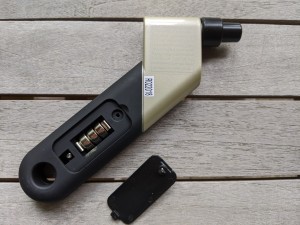 tire gauge
tire gauge
OVERALL SCORE: 76
Pros:
- Highly Accurate
- Ergonomic Design
- Easy Valve Alignment
Cons:
- No Bleeder Valve
- Display Can Be Difficult to Read
- Unit Cycling Not Intuitive
Specifications:
| Feature | Specification |
|---|---|
| Increments | 0.5 psi |
| PSI Range | 5 to 150 |
| Accuracy | +/- (1%+1LSD) – Recalibration Directions |
| Unit Settings | PSI, BAR, kPa, Kg/cm² |
| Operating Temp | 14 to 122F |
The Accutire MS-4021 Digital stands out as the best overall digital tire gauge due to its consistent accuracy and user-friendly design. While it may lack visual flair, its performance is what truly matters when it comes to a tire pressure gauge. Its thoughtfully designed ergonomic shape ensures your thumb’s pressure is directly aligned with the tire valve, leading to consistently accurate readings. The rubberized handle adds to the comfortable grip, accommodating various hand sizes. A practical feature is its ability to freeze the pressure reading on the display, eliminating the struggle to quickly read it before it disappears.
Accuracy is paramount, and the Accutire delivers with precision down to 0.5 PSI. It also offers the convenience of user recalibration, maintaining its accuracy over time. Furthermore, its operational temperature range, extending down to 14 degrees Fahrenheit, surpasses many digital gauges, making it reliable even in colder climates. However, the digital display, while functional, isn’t the easiest to read. In certain lighting, angling the rose-colored LCD screen becomes necessary. Switching between pressure units could also be more straightforward, requiring a somewhat lengthy press-and-hold of the “wake up” button. The Accutire’s lightweight build can feel less substantial, and replacing the LR44 coin batteries can be a minor inconvenience. Despite these minor drawbacks, the Accutire MS-4021 remains our top pick and the best tire gauge for most car owners to keep in their glove compartment. For those seeking a budget-friendly alternative, the analog Milton S-921 Pencil Gauge is a durable and reliable option, although it lacks the digital precision.
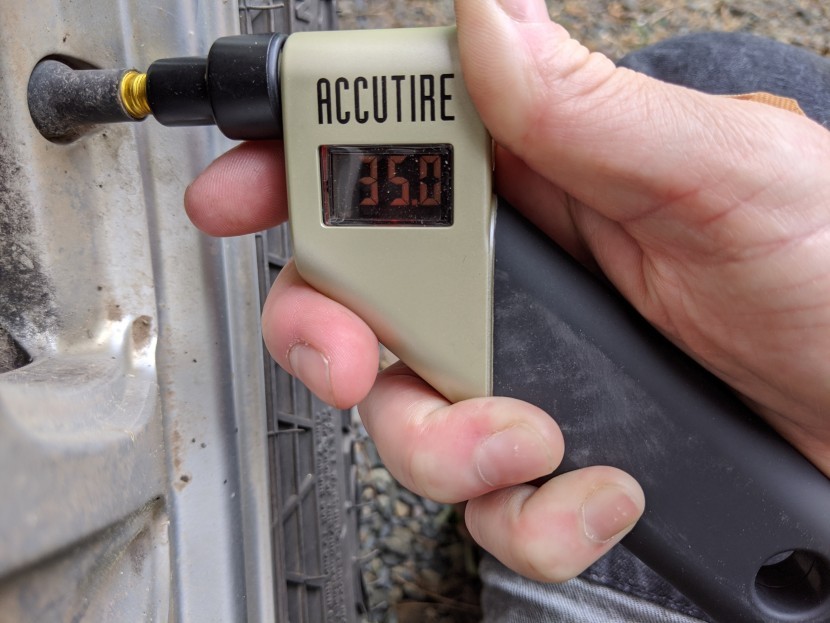 Accurate and easy to use tire gauge
Accurate and easy to use tire gauge
The Accutire is accurate and easy to use, making it a top contender for the best tire gauge. Our only minor complaint is the readability of the display in certain conditions.
Credit: Clark Tate
JACO ElitePro 100 PSI: The Best Battery-Free Tire Gauge
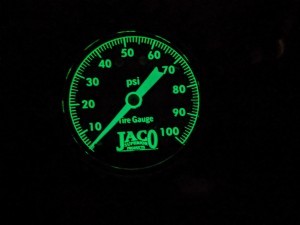 tire gauge
tire gauge
OVERALL SCORE: 65
Pros:
- Certified Accuracy (ANSI Standards)
- Robust Construction
- User-Friendly Operation
- Glow-in-the-Dark Dial
Cons:
- Higher Price Point
- Durability Concerns Possible
- Bulky Design
Specifications:
| Feature | Specification |
|---|---|
| Increments | 1 psi |
| PSI Range | 0 to 100 |
| Accuracy | ANSI B40.1 Grade B Certified (±1.5%) |
| Unit Settings | PSI |
| Operating Temp | Reliable down to -10F |
The JACO ElitePro 100 PSI earns its place as the best battery-free tire gauge, combining accuracy with a durable, mechanical design. It’s certified to ANSI standards (±1.5%), assuring reliable readings. Its solid build and swivel chuck design make achieving a secure valve seal straightforward, which is essential for accurate measurements. The 360-degree swivel chuck, deeper than similar models like the Rhino, firmly holds the tire valve, enhancing the chances of getting a correct reading on the first try. Dial-style gauges offer advantages, including a bleeder valve that allows controlled air release, a function the JACO performs effectively thanks to its tight seal. Another benefit is their resilience to cold temperatures, unlike digital gauges that can be affected by extreme cold. The JACO is functional even in sub-zero conditions and features a glow-in-the-dark dial for nighttime use.
The JACO boasts a well-constructed design with a “leak-proof” rubber hose, brass chuck, and robust connection points. While dial gauges are inherently less impact-resistant than some digital or stick gauges, the JACO’s rubber guard provides some protection. However, it’s a more expensive option, and the long hose makes it less compact for glove box storage. If you prioritize accuracy and battery-free reliability, the JACO ElitePro 100 PSI is a top choice and arguably the best tire gauge in the analog category. For a more budget-conscious battery-free option, consider the TireTek 0-60 PSI, which is simpler and more portable than the JACO.
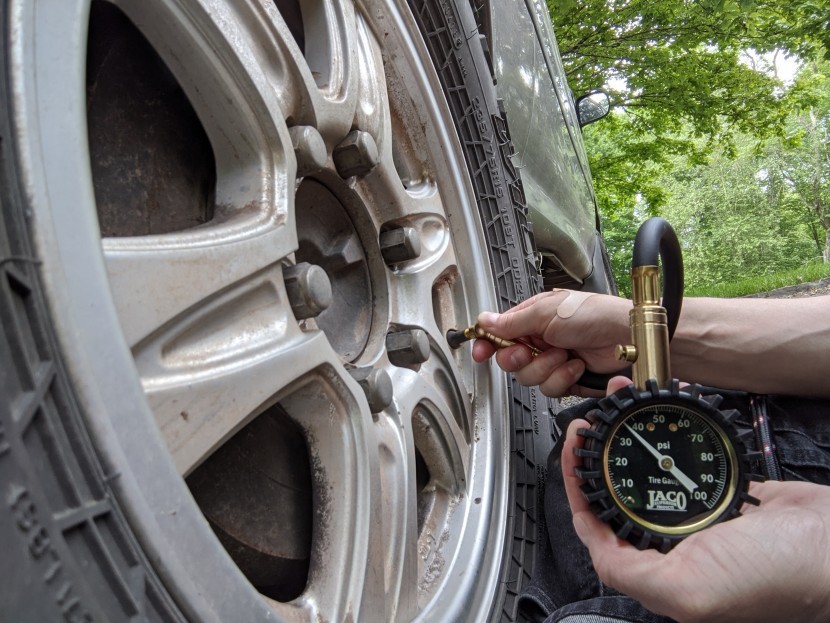 Two-handed operation for accurate readings
Two-handed operation for accurate readings
The JACO, although requiring two hands for optimal use, ensures a consistent seal, delivering accurate tire pressure readings and making it a contender for the best tire gauge for precision. It also simplifies precise air release.
Credit: Clark Tate
Milton S-921 Pencil Gauge: The Best Budget-Friendly Tire Gauge
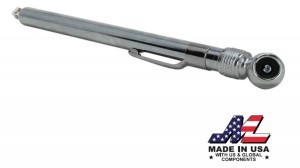 tire gauge
tire gauge
OVERALL SCORE: 57
Pros:
- Extremely Durable
- Battery-Free Operation
- All-Temperature Functionality
- Integrated Deflator
- Highly Portable
Cons:
- Lower Accuracy
- Limited Pressure Range
- Reading Interpretation Can Be Difficult
Specifications:
| Feature | Specification |
|---|---|
| Increments | 1 PSI, 10 kPa |
| PSI Range | 0 to 50 |
| Accuracy | Not Specified |
| Unit Settings | PSI, kPa |
| Operating Temp | All Temperatures |
The Milton S-921 Pencil Gauge is a classic for a reason and represents the best budget-friendly tire gauge. It’s a reliable backup to keep in your car. Made in the USA from durable plated brass, it’s built to last. Analog pencil gauges are renowned for their robustness and compact size, easily fitting into any glove box, no matter how full. With a simple design featuring only one moving part and no batteries, it operates reliably in virtually any condition, including extreme temperatures. It also includes a built-in deflator tab for releasing air, although it doesn’t allow for precise pressure adjustment.
However, pencil gauges aren’t known for pinpoint accuracy, and the Milton is no exception. In our tests, it consistently read about 1 PSI higher than other gauges. While not ideal for precise measurements, it provides a general indication of tire pressure in emergencies. Its strengths lie in its foolproof operation, affordability, and compact size. For users prioritizing accuracy without sacrificing durability, the Accutire MS-4021 Digital, our top overall pick, offers superior accuracy and still fits comfortably in a glove box or center console, making it a strong contender for the best tire gauge even when budget is a concern.
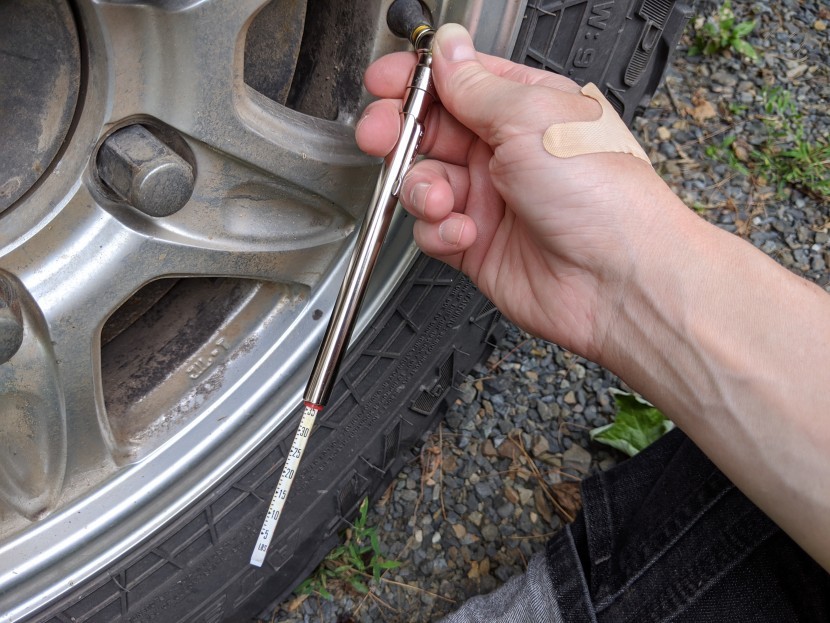 Indestructible and reliable tire gauge
Indestructible and reliable tire gauge
The Milton S-921 gauge is a classic for its durability and reliability, making it the best tire gauge for those prioritizing ruggedness and simplicity, even if readability and absolute accuracy are slightly compromised.
Credit: Clark Tate
AstroAI Digital Dual Head 230 PSI: The Best Heavy-Duty Tire Gauge
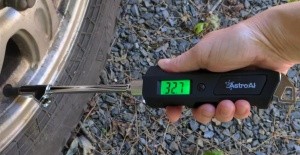 tire gauge
tire gauge
OVERALL SCORE: 68
Pros:
- Ideal for Larger Tires
- Dual Head Design for Trucks
- Excellent Display Readability
- Integrated Flashlight
Cons:
- Bulky for Glove Compartments
- Two-Handed Operation Recommended
- Limited Operating Temperature Range (23 to 122 F)
- No Pressure Release Function
Specifications:
| Feature | Specification |
|---|---|
| Increments | 0.1 PSI |
| PSI Range | 0 to 230 |
| Accuracy | Not Specified |
| Unit Settings | PSI, Bar, Kg/cm², kPa |
| Operating Temp | 23 to 122F |
For vehicles with inward-facing tire valves or tires requiring higher pressure levels, the AstroAI Digital Dual Head 230 PSI is the best heavy-duty tire gauge. Its dual head design ensures a good seal with tire valves regardless of their orientation. The bright green backlit LCD screen is exceptionally easy to read, and the built-in flashlight aids in locating valve stems in low-light conditions. The stainless-steel chuck adds to its durability, and battery replacement (AAA batteries) is straightforward. The extended length of the gauge allows for operation further from the tire valve, but this can also make alignment trickier and potentially lead to air leakage and less accurate readings. Using two hands improves stability and accuracy.
Its larger size makes it less suitable for standard glove compartments, and it’s more geared towards trucks, RVs, or shop use. While perhaps overkill for typical passenger cars, it’s a robust option for those needing a heavy-duty gauge with excellent readability and features. Some users find it ideal as a shop backup, while others appreciate its ruggedness and easy-to-read display, even if it takes up more space. For users seeking greater accuracy and battery-free operation, the JACO ElitePro 100 PSI offers a balance of ease of use and reliability across various conditions and remains a strong contender for the best tire gauge overall for many applications.
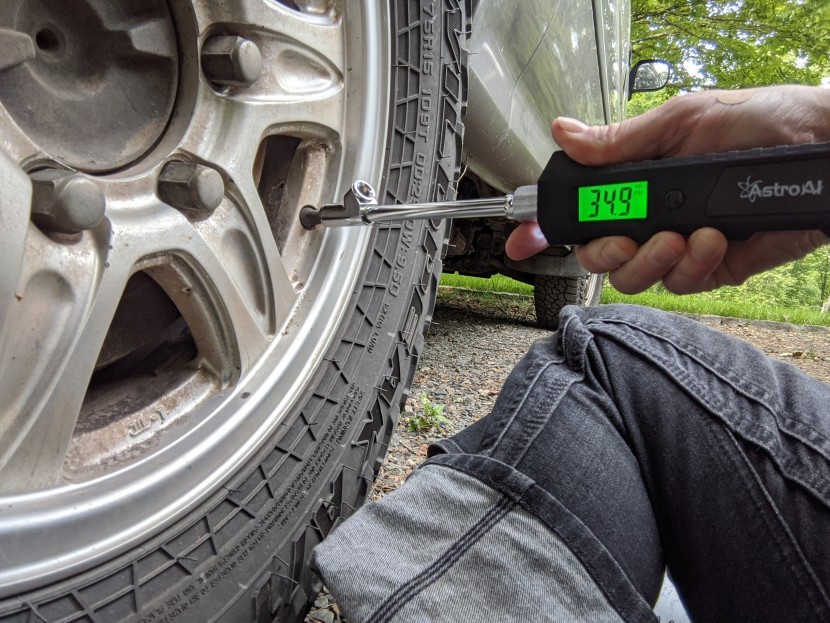 Dual-head design for versatile valve access
Dual-head design for versatile valve access
The AstroAI Digital Dual Head, with its specialized dual-head design, is the best tire gauge for heavy-duty applications, accommodating both inward and outward-facing valves, and featuring a durable build, flashlight, and a bright, easily readable display.
Credit: Clark Tate
Product Comparison: Finding the Best Tire Gauge for Your Needs
The tire gauge contenders lined up for comparison, helping you choose the best tire gauge from the variety of available options.
Credit: Clark Tate
How We Tested for the Best Tire Gauge
Our testing process involved purchasing each tire gauge, thoroughly reviewing user manuals, and developing a comprehensive test plan to objectively evaluate their strengths and weaknesses. We enlisted car and motorcycle enthusiasts with extensive experience to provide expert assessments. Our evaluations focused on accuracy, durability, ease of use, readability, and features. Our goal was to identify the best tire gauge for various needs, from a convenient glove compartment tool to the most consistently accurate instrument, ensuring you can maintain optimal tire pressure effortlessly.
Our tire gauge evaluations were based on five key metrics:
- Accuracy (30% weighting): This is the most critical factor for a tire gauge, as precise readings are essential for safety and tire maintenance.
- Durability (25% weighting): A tire gauge should withstand regular use and occasional bumps and drops.
- Ease of Pressure Check (15% weighting): The gauge should be easy to attach to the tire valve and provide a consistent reading with minimal air loss.
- Ease of Reading (15% weighting): The display should be clear and easy to interpret in various lighting conditions.
- Features (15% weighting): Extra features like bleeder valves, flashlights, and multiple unit settings can enhance user experience.
Why Trust Our Tire Gauge Reviews
Our lead tester, Clark Tate (Clark Tate’s Author Profile), is a vanlifer and mountain biker who relies on dependable tools for on-the-road maintenance. Her daily routines involve using tire gauges to optimize mountain bike tire pressure for group rides and regularly checking her 1994 4×4 Toyota Hiace tire pressure for highway and off-road journeys. From adjusting tire pressure for Baja beaches to preparing for long road trips, Clark is intimately familiar with tire maintenance and the importance of accurate tire pressure readings. Her extensive experience makes her uniquely qualified to assess and recommend the best tire gauge.
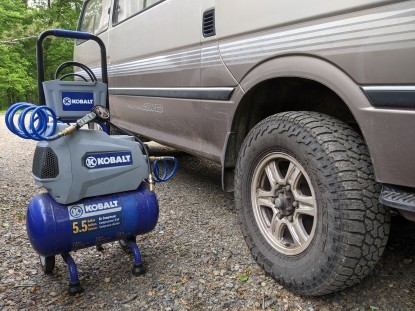 Air compressor for efficient testing
Air compressor for efficient testing
A Kobalt air compressor was instrumental in our testing, allowing us to efficiently standardize tire pressures for each gauge evaluation in our search for the best tire gauge.
We meticulously tested each tire gauge on all four tires repeatedly to maximize the number of readings and ensure a thorough evaluation in our quest to determine the best tire gauge.
Detailed Analysis and Test Results for Best Tire Gauges
We rigorously tested each tire gauge for accuracy, ease of use, and durability. Using a digital tire inflator, we standardized tire pressure to 35 PSI and took ten readings with each gauge, repeating this process three times to obtain average readings for accuracy and ease of use assessments. Beyond standardized tests, we also evaluated each gauge’s features to help you identify the best tire gauge tailored to your specific needs.
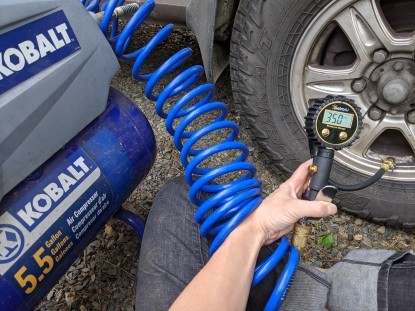 Standardizing tire pressure for accuracy testing
Standardizing tire pressure for accuracy testing
We used an AstroAI inflator gauge to reset tire pressures to 35 PSI after every ten readings during accuracy testing, maintaining consistent conditions for evaluating each best tire gauge contender.
Credit: Clark Tate
Best Value Tire Gauges
While tire gauges are generally affordable, prices vary. For a basic, budget-friendly option, the Milton S-921 Pencil Gauge is a classic, foolproof pencil gauge at a very low price, making it an excellent backup. For a digital option that’s still wallet-friendly, the AstroAI Digital 150 PSI is recommended, offering a bright display at a slightly higher cost. However, for overall value considering performance and features, the Accutire MS-4021 Digital provides an excellent balance and earns its place as a top contender for the best tire gauge without breaking the bank.
Accuracy Performance
Accurate tire pressure is paramount for safety, tire longevity, fuel economy, and environmental responsibility. The Accutire MS-4021 Digital excelled in our accuracy tests. Its ergonomic design helped achieve consistent seals with minimal air leakage during measurements. It consistently matched the reference pressure from our air compressor and includes recalibration instructions. This makes it the best tire gauge for users prioritizing precision.
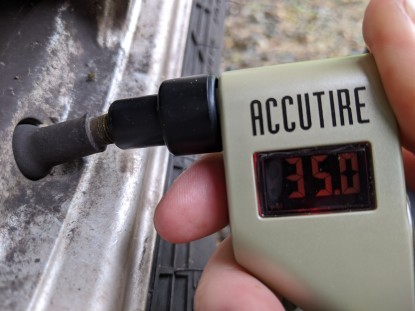 Accurate readings with minimal air loss
Accurate readings with minimal air loss
The Accutire gauge consistently delivered accurate pressure readings, releasing minimal air during testing, reinforcing its position as the best tire gauge for accuracy.
Credit: Clark Tate
The JACO ElitePro and TireTek 0-60 PSI also performed well in accuracy tests, with ANSI certifications of ±1.5% and ±2% respectively. The Rhino USA gauge, also ANSI certified at ±1.5%, was less consistent than the top performers. The AstroAI digital gauges performed well, with the handgun model slightly edging out the heavy-duty version. Digital gauges like the Accutire have temperature limitations (14 to 122 degrees F), relevant in extremely cold climates. Battery-saving auto-shutoff features in digital gauges can also be inconvenient if readings are lost due to unexpected shutdowns.
Analog dial gauges like the JACO and TireTek, and stick gauges like the Milton S-921, avoid these issues. While the Milton S-921 consistently read 1 PSI high, it remains functional in all temperatures. The Topeak SmartGauge D2 is accurate with a good seal, but its shallow chuck makes achieving a reliable seal challenging. Considering accuracy across various types, the Accutire MS-4021 Digital remains the best tire gauge for most users.
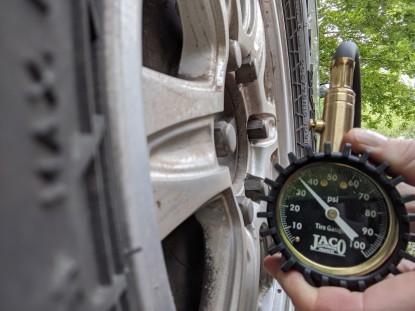 Consistent seal with JACO gauge
Consistent seal with JACO gauge
The well-designed chuck on the JACO gauge ensured a solid seal every time, contributing to its accurate readings and making it a strong contender for the best tire gauge in terms of consistent performance.
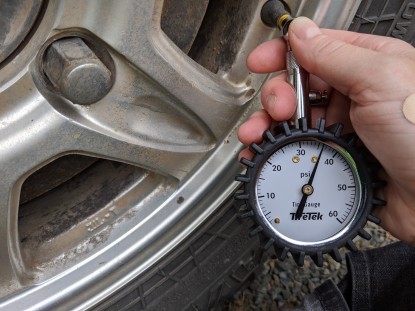 Easy seal and readable display of TireTek gauge
Easy seal and readable display of TireTek gauge
The TireTek gauge’s ease of achieving a good seal with one hand and its bright, readable dial enhance its usability, placing it among the considerations for the best tire gauge for user-friendliness.
The Jaco (left) and TireTek (right) both feature reliable dial gauges known for consistent performance.
Durability Assessment
While we didn’t conduct destructive testing, our long-term experience suggests the Milton pencil gauge is virtually indestructible. Dial gauges, while generally robust, might be more vulnerable to damage (though we are optimistic about the JACO). Digital gauges’ durability is harder to predict and can vary. Online reviews support these general observations. For sheer ruggedness, the Milton S-921 is arguably the best tire gauge.
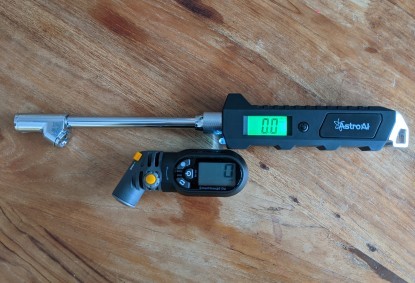 Durable tire gauges for various conditions
Durable tire gauges for various conditions
The AstroAI Dual Head, Topeak SmartGauge D2, Milton, and Accutire gauges all demonstrate varying degrees of durability, capable of handling regular use and some level of rough handling, making them all considerations for the best tire gauge based on longevity.
Credit: Clark Tate
The heavy-duty AstroAI Dual Head with its steel chuck inspires confidence in its durability. It withstood regular use in non-professional settings well. The Topeak and Accutire models, with replaceable batteries and minimal breakable parts, are also expected to last. One tester reported years of reliable use from the Topeak gauge. Dial gauges with rubber guards, like the JACO and TireTek, offer some impact protection, but their moving parts are inherently more delicate. The Rhino’s braided hose appears to be a potential weak point. Overall, for a balance of durability and features, the Accutire MS-4021 Digital remains a strong contender for the best tire gauge.
Ease of Pressure Checking
A gauge’s ease of use directly impacts its accuracy. Gauges that create consistent seals minimize air loss and ensure reliable readings. The Accutire, TireTek, and Milton gauges excelled in forming consistent seals, largely due to deeper chuck wells that properly align with the tire valve stem. The JACO also shares this feature, making it easy to get a good seal, although it requires two hands. For single-handed ease of use and consistent sealing, the Accutire MS-4021 Digital is arguably the best tire gauge.
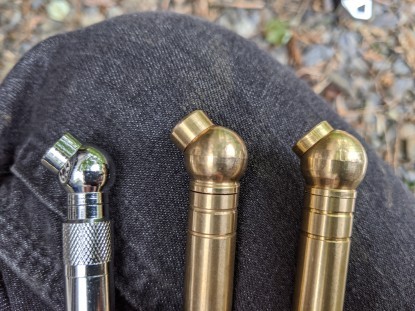 Chuck designs for optimal valve alignment
Chuck designs for optimal valve alignment
The TireTek and JACO chucks (left) feature guideposts that aid in aligning the gauge with the tire valve, reducing accidental air release. The Rhino chuck (right) lacks this, making air leakage more likely, highlighting the importance of chuck design in selecting the best tire gauge for ease of use.
Credit: Clark Tate
The Accutire‘s angled design and thumb imprint enhance alignment and ease of use. The AstroAI Dual Head is also user-friendly, though its length can make alignment tricky if holding the rubberized handle. Gripping the metal section with both hands improves consistency. The Rhino and AstroAI gun gauges were less consistent, with the Rhino’s shallow chuck leading to accidental air release, a problem also observed with the Topeak.
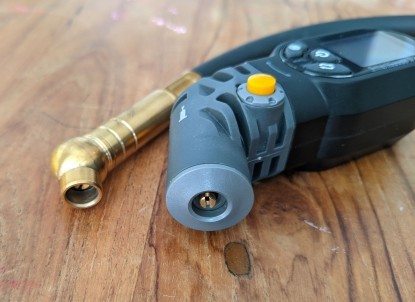 Shallow chuck design challenges
Shallow chuck design challenges
The shallow chuck on the Topeak gauge can lead to misalignment with the valve, while the deeper-set JACO chuck offers easier alignment, illustrating how chuck design impacts the user-friendliness of a best tire gauge contender.
Credit: Clark Tate
Readability of Displays
Display readability varies significantly among tire gauges. The AstroAI Dual Head‘s bright green backlit display is exceptional, readable from a distance. The AstroAI gun gauge, with its blue LCD, is a close second. Both have easy unit switching. The bright white TireTek dial is also very readable, though it lacks illumination. For display clarity, the AstroAI Digital Dual Head 230 PSI is the best tire gauge.
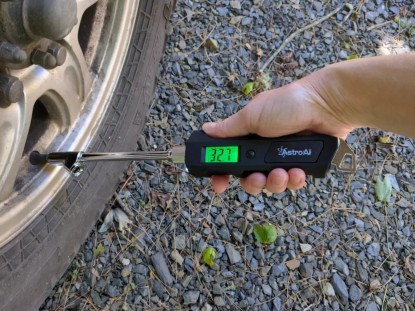 Highly readable display of AstroAI Dual Head
Highly readable display of AstroAI Dual Head
The AstroAI Dual Head gauge eliminates the need to bend down to read the pressure, thanks to its dayglow display, making it the best tire gauge for readability in various conditions.
Credit: Clark Tate
In contrast, the Accutire’s display is less user-friendly, requiring adjustments for optimal viewing in certain lighting. The Milton pencil gauge also suffers in readability; discerning precise readings can be difficult. The Topeak‘s large digital display is better but unlit, requiring a flashlight at night. All tested gauges hold readings briefly. Dial gauges hold readings until pressure release, stick gauges until manual reset, and digital gauges shut off automatically after a short period (20-40 seconds), which can be inconvenient if interrupted. For consistently readable displays, especially in low light, the digital AstroAI models are top choices for the best tire gauge.
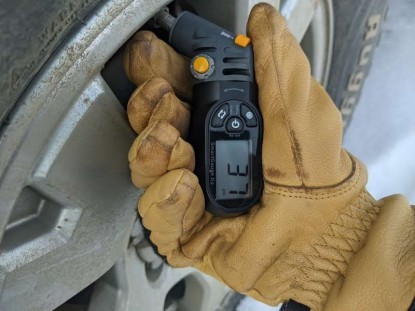 Easy-to-read digital display of Topeak SmartGauge D2
Easy-to-read digital display of Topeak SmartGauge D2
The Topeak SmartGauge D2 digital display offers good readability in daylight conditions, but lacks illumination for nighttime use, highlighting a trade-off in display features when considering the best tire gauge for all-condition readability.
Credit: Clark Tate
Key Features
Feature sets vary, with dial gauges offering measurable pressure relief valves and digital models providing flashlights and illuminated displays. The digital Topeak includes a bleeder valve, requiring button presses to activate and deactivate it for accurate readings. The Milton stick gauge also has a deflator, but without measurement capability. For feature-rich options, the digital gauges, especially the AstroAI models with flashlights, offer added convenience, while dial gauges like the JACO and Rhino with glow-in-the-dark dials provide nighttime visibility.
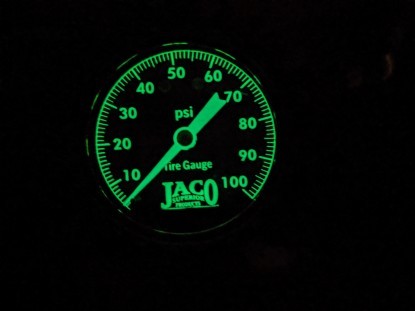 Glow-in-the-dark feature of JACO gauge
Glow-in-the-dark feature of JACO gauge
The JACO and Rhino gauges feature glow-in-the-dark dials, a thoughtful addition that enhances usability in low-light conditions, making them considerations for the best tire gauge for nighttime use.
Credit: Clark Tate
With the right tire gauge, you’re ready for any road trip, ensuring your tires are perfectly inflated for safety and performance – choosing the best tire gauge is the first step to a smooth journey.
Credit: Clark Tate
Conclusion: Choosing the Best Tire Gauge for Your Needs
We hope this comprehensive review has helped you identify the best tire gauge to suit your specific requirements. While these tools are generally inexpensive, selecting the right one can save frustration, time, and money in the long run. For further essential automotive tools, explore our recommendations on tool sets to keep your vehicle running smoothly. Here’s to safe travels with perfectly inflated tires, thanks to your best tire gauge!
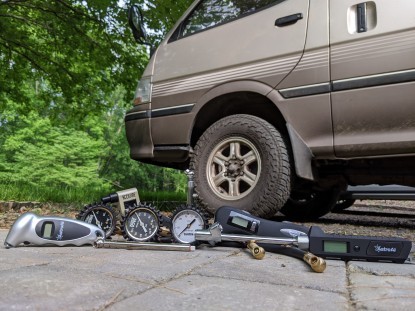 Tire gauge contenders
Tire gauge contenders Rigorous testing process
Rigorous testing process Road trip ready
Road trip ready